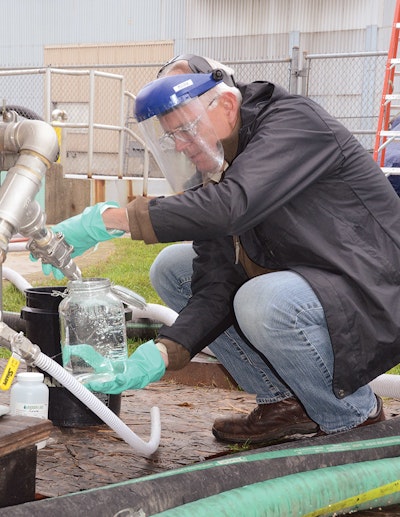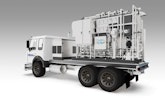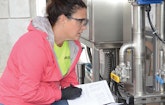
The Crane Engineering team includes (from left) Mark Hassman, program director; Jill Georger, lead developing engineer; and Mike Blodgett, operations engineer. (Photos by Jim Kneiszel)
The NASA program achieved former President John F. Kennedy’s goal to land a man on the moon and bring him safely back by the end of the 1960s. But the space program, in its quest to achieve that seemingly impossible feat, provided so much more. When the government threw so many resources into sending a rocket to the moon, it developed untold technologies that power so many innovations we all use today.
Something similar may be going on right now in the world of wastewater. Many efforts are being made to improve effluent treatment in onsite systems as well as technologies to more efficiently treat the sludge removed from septic tanks. One of those projects is happening in Kimberly, Wisconsin, where a small engineering team is about to launch a mobile septage treatment system aimed at better treating waste in crowded communities in third-world countries.
Crane Engineering, supported by more than $5 million in grants from a humanitarian organization, has only been working on the design and production of a working prototype for a few years. The Oystra unit is 6 feet wide, 12 feet long, 8 feet high and weighs 18,000 pounds. It has been processing septage in the testing phase for several months, and it currently produces 50 gallons of pathogen-, virus- and bacteria-free water per minute. That water can be safely dumped anywhere or be reused for many purposes, and those developing the system are moving toward potable water discharge.
HELP FOR PUMPERS
Once this technology reaches its intended audience in developing nations, it could potentially be unleashed to help solve a growing disposal problem for pumpers everywhere. And that would be good news. Septic service companies are facing rising per-gallon costs for dumping and a dwindling number of municipal plants willing to take on septage, much less challenging loads of fats, oils and grease (FOG).
Imagine a truck-mounted processing plant that can quickly separate your collected waste into 75% locally discharged or recycled clean water and 25% solids. That would mean your truck could take the waste of four tanks to every one you are handling now. If you currently have to make a long trip to the treatment plant after three service calls, it’s possible you could run the waste from 12 tanks through the mobile unit before dumping.
Engineer Mark Hassman, program director for the Oystra project, says wastewater companies in Africa have told him they envision having several units placed strategically throughout their densely populated service areas and moving them around every few weeks, operating them 24 hours a day. They would run small trucks to the septic tanks or crude pit latrines, then have a large vacuum truck stationed with the processing plant to collect the solids and run much bigger loads to treatment plants.
“Our mission is to fulfill the grant requirements and process human waste in developing countries, but we see applications eventually in dairy, hog and human waste in the states,” says Hassman, who met with pumpers during a recent meeting of the Wisconsin Liquid Waste Carriers Association.
Hassman went to Africa in July 2017 to see the sanitary conditions in tightly packed slums, where waste is often collected in dirt-walled pits, pumped into trucks or manually emptied, and then transported either to a treatment plant or, sadly, sometimes dumped directly into the ocean.
UP AND RUNNING
I was fortunate to see the Crane Engineering prototype in action where it was set up for testing at the Heart of the Valley Metropolitan Sewerage District plant in Kaukauna, Wisconsin. The unit was placed next to the septage receiving station and pumper trucks came and went while I was present, dumping loads that were brought to the unit through pumps set up by the company. Both the clean processed water and concentrated solids were returned to the receiving station and processed by the plant.
The design of the unit is proprietary so I couldn’t photograph the working parts, but I can say it’s made of stainless steel components, it automatically adjusts to handle the waste strength received, and it is required by the granting body to handle anything that fits through a 3-inch hose, including things like shoes and two-by-fours.
“There are three sets of filters, each one progressively smaller and smaller. There are some consumables in the unit; our projections are that they should last 1 1/2 to two years,” Hassman explains. Currently a cleaning procedure for the unit is done manually, but the Crane Engineering team is working on an automated system to make it a “one-button, walk-away” operation.
What about the performance numbers? The granting agency requires BOD of 20 mg/L or lower, COD of 50 mg/L or lower, TSS of up to 20 mg/L, pH levels between 6 and 9 and a turbidity NTU of less than 200. The Oystra “gold” level treatment produces BOD of 13 mg/L, COD of 16 mg/L, TSS of zero, 6.5 pH and turbidity NTU of 0.5. Depending on customer needs, the unit can produce slightly lower-quality effluent and the team is working toward a potable water option.
MOVING AHEAD FAST
The prototype was transported to Washington state in the fall for further testing. Interestingly, Washington state communities have minimal regulations requiring periodic septic pumping and inspection; therefore the state presents a bigger treatment challenge for the unit. With Wisconsin’s strict requirements for routine pumping and inspection of septic tanks, the septage going into the Oystra has not yet reached 1% solids, according to Hassman. In Washington state, solids are expected in the 5%-6% range.
After further testing and demonstrations, Hassman hopes to move the unit to its intended destination in Dakar, Senegal. That couldn’t come soon enough for Hassman, who had the unfortunate experience of witnessing what is called “manual emptying” of a pit in Africa.
“If there is a lot of trash or (the pit) is far away from a road … they take buckets and scoop it out.” He describes watching a worker go into a pit to remove waste and debris: “They just lowered him down. He took off his clothes, kept his underwear on, and took out the last little bit. When he came out, they took a 5-gallon bucket of disinfectant and poured it over his head. He lathered up and dried off with a towel and put his clothes back on.
“In most places that is outlawed, but it still happens. We witnessed it, and it was very unsafe in the fact that no oxygen measurements were taken before he went down, and when he came out, obviously he wasn’t clean.”
MAKING A DIFFERENCE
They still face hurdles, but Hassman says it’s been a gratifying experience.
“The team works a lot of long hours, and it’s not the nicest environment. We’ve tested in monsoons and when it was 24 degrees F,” he says. “It’s very demanding, and it has been incredibly satisfying. None of us will regret working on this, but we haven’t saved a life yet, and that’s the mission.”
With this project and improved dewatering and small-scale treatment options being developed by others in the wastewater industry, there is reason to be hopeful that worldwide disposal challenges will be overcome. The future of decentralized wastewater treatment as a viable alternative depends on access to convenient and lower-cost handling of the water and solids you haul away from homes and businesses.









